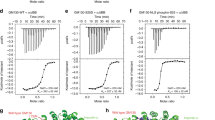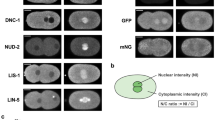Abstract
The RanGTPase cycle provides directionality to nucleocytoplasmic transport, regulating interactions between cargoes and nuclear transport receptors of the importin-β family1,2. The Ran–importin-β system also functions in mitotic spindle assembly and nuclear pore and nuclear envelope formation1,3,4. The common principle underlying these diverse functions throughout the cell cycle is thought to be anisotropy of the distribution of RanGTP (the RanGTP gradient), driven by the chromatin-associated guanine nucleotide exchange factor RCC1 (refs 1, 4, 5). However, the existence and function of a RanGTP gradient during mitosis in cells is unclear. Here we examine the Ran–importin-β system in cells by conventional and fluorescence lifetime microscopy using a biosensor, termed Rango, that increases its fluorescence resonance energy transfer signal when released from importin-β by RanGTP. Rango is predominantly free in mitotic cells, but is further liberated around mitotic chromatin. In vitro experiments and modelling show that this localized increase of free cargoes corresponds to changes in RanGTP concentration sufficient to stabilize microtubules in extracts. In cells, the Ran–importin-β–cargo gradient kinetically promotes spindle formation but is largely dispensable once the spindle has been established. Consistent with previous reports6,7,8, we observe that the Ran system also affects spindle pole formation and chromosome congression in vivo. Our results demonstrate that conserved Ran-regulated pathways are involved in multiple, parallel processes required for spindle function, but that their relative contribution differs in chromatin- versus centrosome/kinetochore-driven spindle assembly systems.
This is a preview of subscription content, access via your institution
Access options
Subscribe to this journal
Receive 51 print issues and online access
$199.00 per year
only $3.90 per issue
Buy this article
- Purchase on Springer Link
- Instant access to full article PDF
Prices may be subject to local taxes which are calculated during checkout




Similar content being viewed by others
References
Weis, K. Regulating access to the genome: nucleocytoplasmic transport throughout the cell cycle. Cell 112, 441–451 (2003)
Pemberton, L. F. & Paschal, B. M. Mechanisms of receptor-mediated nuclear import and nuclear export. Traffic 6, 187–198 (2005)
Hetzer, M., Gruss, O. J. & Mattaj, I. W. The Ran GTPase as a marker of chromosome position in spindle formation and nuclear envelope assembly. Nature Cell Biol. 4, E177–E184 (2002)
Harel, A. & Forbes, D. J. Importin-β: conducting a much larger cellular symphony. Mol. Cell 16, 319–330 (2004)
Hetzer, M., Bilbao-Cortes, D., Walther, T. C., Gruss, O. J. & Mattaj, I. W. GTP hydrolysis by Ran is required for nuclear envelope assembly. Mol. Cell 5, 1013–1024 (2000)
Ciciarello, M. et al. Importin-β is transported to spindle poles during mitosis and regulates Ran-dependent spindle assembly factors in mammalian cells. J. Cell Sci. 117, 6511–6522 (2004)
Arnaoutov, A. & Dasso, M. The Ran GTPase regulates kinetochore function. Dev. Cell 5, 99–111 (2003)
Arnaoutov, A. et al. Crm1 is a mitotic effector of Ran-GTP in somatic cells. Nature Cell Biol. 7, 626–632 (2005)
Huber, J., Dickmanns, A. & Luhrmann, R. The importin-β binding domain of snurportin1 is responsible for the Ran- and energy-independent nuclear import of spliceosomal U snRNPs in vitro. J. Cell Biol. 156, 467–479 (2002)
Rizzo, M. A., Springer, G. H., Granada, B. & Piston, D. W. An improved cyan fluorescent protein variant useful for FRET. Nature Biotechnol. 22, 445–449 (2004)
Kalab, P., Weis, K. & Heald, R. Visualization of a Ran-GTP gradient in interphase and mitotic Xenopus egg extracts. Science 295, 2452–2456 (2002)
Suhling, K., French, P. M. & Phillips, D. Time-resolved fluorescence microscopy. Photochem. Photobiol. Sci. 4, 13–22 (2005)
Becker, W. et al. Fluorescence lifetime imaging by time-correlated single-photon counting. Microsc. Res. Tech. 63, 58–66 (2004)
Shelby, R. D., Hahn, K. M. & Sullivan, K. F. Dynamic elastic behaviour of alpha-satellite DNA domains visualized in situ in living human cells. J. Cell Biol. 135, 545–557 (1996)
Gorlich, D., Seewald, M. J. & Ribbeck, K. Characterization of Ran-driven cargo transport and the RanGTPase system by kinetic measurements and computer simulation. EMBO J. 22, 1088–1100 (2003)
Riddick, G. & Macara, I. G. A systems analysis of importin-α-β mediated nuclear protein import. J. Cell Biol. 168, 1027–1038 (2005)
Nachury, M. V. et al. Importin-β is a mitotic target of the small GTPase Ran in spindle assembly. Cell 104, 95–106 (2001)
Wollman, R. et al. Efficient chromosome capture requires a bias in the 'search-and-capture' process during mitotic-spindle assembly. Curr. Biol. 15, 828–832 (2005)
Acknowledgements
The authors wish to thank T. Nishimoto, M. Dasso, J. Fang, M. A. Rizzo, D. W. Piston and F. Melchior for providing reagents, and C. Weirich for performing fluorescence polarization assays. We are grateful to A. Arnaoutov for discussion and sharing unpublished results, C. Weirich, M. Blower, A. Madrid and H. Aaron for critical reading of the manuscript, and members of the Heald and Weis laboratories for discussions. The research described in this article was supported in part by Philip Morris USA Inc. and Philip Morris International (R.H.), and by grants from the National Institute of Health (E.Y.I., R.H. and K.W.). Author Contributions P.K. and A.P. contributed equally to this project.
Author information
Authors and Affiliations
Corresponding authors
Ethics declarations
Competing interests
Reprints and permissions information is available at npg.nature.com/reprintsandpermissions. The authors declare no competing financial interests.
Supplementary information
Supplementary Notes
This file contains Supplementary Figures 1–9, Supplementary Table 1, Supplementary Methods and additional references. (DOC 730 kb)
Rights and permissions
About this article
Cite this article
Kaláb, P., Pralle, A., Isacoff, E. et al. Analysis of a RanGTP-regulated gradient in mitotic somatic cells. Nature 440, 697–701 (2006). https://doi.org/10.1038/nature04589
Received:
Accepted:
Issue Date:
DOI: https://doi.org/10.1038/nature04589
This article is cited by
-
Mechanisms underlying spindle assembly and robustness
Nature Reviews Molecular Cell Biology (2023)
-
Acentrosomal spindles assemble from branching microtubule nucleation near chromosomes in Xenopus laevis egg extract
Nature Communications (2023)
-
Effects of Ran-GTP/importin β inhibition on the meiotic division of porcine oocytes
Histochemistry and Cell Biology (2022)
-
Regulation of the small GTPase Ran by miR-802 modulates proliferation and metastasis in colorectal cancer cells
British Journal of Cancer (2020)
-
The coming-of-age of nucleocytoplasmic transport in motor neuron disease and neurodegeneration
Cellular and Molecular Life Sciences (2019)
Comments
By submitting a comment you agree to abide by our Terms and Community Guidelines. If you find something abusive or that does not comply with our terms or guidelines please flag it as inappropriate.



